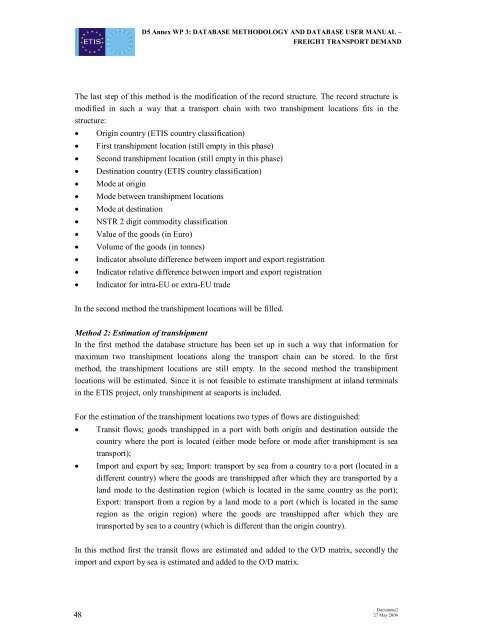D5 Annex report WP 3: ETIS Database methodology ... - ETIS plus
D5 Annex report WP 3: ETIS Database methodology ... - ETIS plus
D5 Annex report WP 3: ETIS Database methodology ... - ETIS plus
Create successful ePaper yourself
Turn your PDF publications into a flip-book with our unique Google optimized e-Paper software.
<strong>D5</strong> <strong>Annex</strong> <strong>WP</strong> 3: DATABASE METHODOLOGY AND DATABASE USER MANUAL –<br />
FREIGHT TRANSPORT DEMAND<br />
The last step of this method is the modification of the record structure. The record structure is<br />
modified in such a way that a transport chain with two transhipment locations fits in the<br />
structure:<br />
· Origin country (<strong>ETIS</strong> country classification)<br />
· First transhipment location (still empty in this phase)<br />
· Second transhipment location (still empty in this phase)<br />
· Destination country (<strong>ETIS</strong> country classification)<br />
· Mode at origin<br />
· Mode between transhipment locations<br />
· Mode at destination<br />
· NSTR 2 digit commodity classification<br />
· Value of the goods (in Euro)<br />
· Volume of the goods (in tonnes)<br />
· Indicator absolute difference between import and export registration<br />
· Indicator relative difference between import and export registration<br />
· Indicator for intraEU or extraEU trade<br />
In the second method the transhipment locations will be filled.<br />
Method 2: Estimation of transhipment<br />
In the first method the database structure has been set up in such a way that information for<br />
maximum two transhipment locations along the transport chain can be stored. In the first<br />
method, the transhipment locations are still empty. In the second method the transhipment<br />
locations will be estimated. Since it is not feasible to estimate transhipment at inland terminals<br />
in the <strong>ETIS</strong> project, only transhipment at seaports is included.<br />
For the estimation of the transhipment locations two types of flows are distinguished:<br />
· Transit flows; goods transhipped in a port with both origin and destination outside the<br />
country where the port is located (either mode before or mode after transhipment is sea<br />
transport);<br />
· Import and export by sea; Import: transport by sea from a country to a port (located in a<br />
different country) where the goods are transhipped after which they are transported by a<br />
land mode to the destination region (which is located in the same country as the port);<br />
Export: transport from a region by a land mode to a port (which is located in the same<br />
region as the origin region) where the goods are transhipped after which they are<br />
transported by sea to a country (which is different than the origin country).<br />
In this method first the transit flows are estimated and added to the O/D matrix, secondly the<br />
import and export by sea is estimated and added to the O/D matrix.<br />
48<br />
Document2<br />
27 May 2004
















